|
Ark of the Covenant
THE SIGN AND
THE SEAL
by Graham Hancock
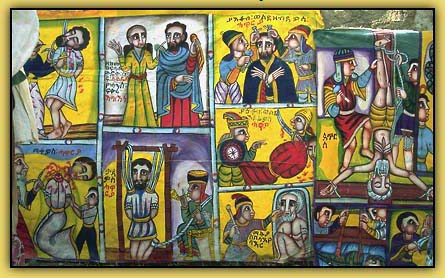
It was growing dark and
the air of the Ethiopian highlands was chill when the monk appeared.
Stooped and leaning on a prayer stick he shuffled towards me from the
doorway of the sanctuary chapel and listened attentively as I was
introduced to him. Speaking in Tigrigna, the local language, he then
sought clarification through my interpreter about my character and my
motives: from which country had I come, what work did I do there, was I
a Christian, what was it that I wanted from him?
Initiation: 1986
I answered each of these questions fully, squinting
through the gloom as I talked, trying to make out the details of my
inquisitor's face. Milky cataracts veiled his small sunken eyes and deep
lines furrowed his black skin. He was bearded and probably toothless -
for although his voice was resonant it was also oddly slurred. All I
could be sure of, however, was that he was an old man, as old as the
century perhaps, that he had his wits about him, and that he did not
seem to be seeking information about me out of idle curiosity. Only when
he was satisfied with everything that I had said did he condescend to
shake hands with me. His grip was dry and delicate as papyrus and from
the thick robes that he wore, faint but unmistakable, arose the holy
odour of frankincense.
Now that the formalities were over I got straight to
the point. Gesturing in the direction of the building that loomed in
shadowy outline behind us, I said: 'I have heard of an Ethiopian
tradition that the Ark of the Covenant is kept here... in this chapel. I
have also heard that you are the guardian of the Ark. Are these things
true?'
'They are true.'
'But in other countries nobody believes these
stories. Few know about your traditions anyway, but those who do say
that they are false.'
'People may believe what they wish. People may say
what they wish. Nevertheless we do possess the sacred Tabot, that is to
say the Ark of the Covenant, and I am its guardian...'
'Let me be clear about this,' I interjected. 'Are you
referring to the original Ark of the Covenant - the box made of wood and
gold in which the Ten Commandments were placed by the prophet Moses?'
'Yes. God Himself inscribed the ten words of the law
upon two tablets of stone. Moses then placed these tablets inside the
Ark of the Covenant - which afterwards accompanied the Israelites during
their wanderings in the wilderness and their conquest of the Promised
Land. It brought them victory wherever they went and made them a great
people. At last, when its work was done, King Solomon placed it in the
Holy of Holies of the Temple that he had built in Jerusalem. And from
there, not long afterwards, it was removed and brought to Ethiopia...'
'Tell me how this happened,' I asked. 'What I know of
your traditions is only that the Queen of Sheba is supposed to have been
an Ethiopian monarch. The legends I have read say that when she made her
famous journey to Jerusalem she was impregnated by King Solomon and bore
him a son - a royal prince - who in later years stole the Ark...'
The monk sighed. 'The name of the prince you are speaking of was
Menelik - which in our language means "the son of the wise man".
Although he was conceived in Jerusalem he was born in Ethiopia where the
Queen of Sheba had returned after discovering that she was carrying
Solomon's child. When he had
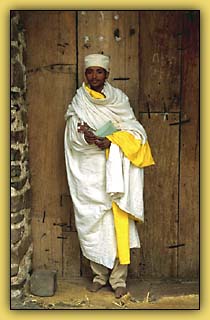 reached the age of twenty, Menelik himself travelled from Ethiopia to
Israel and arrived at his father's court. There he was instantly
recognized and accorded great honour. After a year had passed, however,
the elders of the land became jealous of him. They complained that
Solomon showed him too much favour and they insisted that he must go
back to Ethiopia. This the king accepted on the condition that the
first-born sons of all the elders should also be sent to accompany him.
Amongst these latter was Azarius, son of Zadok the High Priest of
Israel, and it was Azarius, not Menelik, who stole the Ark of the
Covenant from its place in the Holy of Holies in the Temple. Indeed the
group of young men did not reveal the theft to Menelik until they were
far away from Jerusalem. When at last they told him what they had done
he understood that they could not have succeeded in so bold a venture
unless God had willed it. Therefore he agreed that the Ark should remain
with them. And it was thus that it was brought to Ethiopia, to this
sacred city... and here it has remained ever since.'
reached the age of twenty, Menelik himself travelled from Ethiopia to
Israel and arrived at his father's court. There he was instantly
recognized and accorded great honour. After a year had passed, however,
the elders of the land became jealous of him. They complained that
Solomon showed him too much favour and they insisted that he must go
back to Ethiopia. This the king accepted on the condition that the
first-born sons of all the elders should also be sent to accompany him.
Amongst these latter was Azarius, son of Zadok the High Priest of
Israel, and it was Azarius, not Menelik, who stole the Ark of the
Covenant from its place in the Holy of Holies in the Temple. Indeed the
group of young men did not reveal the theft to Menelik until they were
far away from Jerusalem. When at last they told him what they had done
he understood that they could not have succeeded in so bold a venture
unless God had willed it. Therefore he agreed that the Ark should remain
with them. And it was thus that it was brought to Ethiopia, to this
sacred city... and here it has remained ever since.'
'And are you telling me that this
legend is literally true?'
'It is not a legend. It is history.'
'How can you be so sure of that?'
'Because I am the guardian. I know the nature of the object that has
been placed in my care.'
We sat in silence for a few moments while I adjusted my mind to the calm
and rational way in which the monk had told me these bizarre and
impossible things. Then I asked him how and why he had been appointed to
his position. He replied that it was a great honour that he should have
been chosen, that he had been nominated with the last words of his
predecessor, and that when he himself lay on his death-bed his turn
would come to nominate his own successor.
'What qualities will you look for in that man?'
'Love of God, purity of heart, cleanliness of mind and body.'
'Other than you,' I asked next, 'is anyone else allowed to see the Ark?'
'No. I alone may see it.'
'So does that mean that it is never brought out of the sanctuary
chapel?'
The guardian paused for a long while before answering this question.
Then, finally, he told me that in the very distant past the relic had
been brought out during all the most important church festivals. More
recently its use in religious processions had been limited to just one
occasion a year. That occasion was the ceremony known as Timkat which
took place every January.
'So if I come back next January will I have a chance of seeing the Ark?'
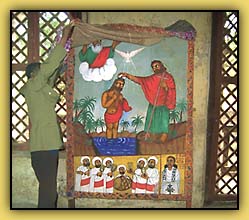 The monk looked at me in a way that I found strangely disconcerting and
then said: 'You must know that there is turmoil and civil war in the
land... Our government is evil, the people oppose it, and the fighting
comes closer every day. In such circumstances it is unlikely that the
true Ark will be used again in the ceremonies.
The monk looked at me in a way that I found strangely disconcerting and
then said: 'You must know that there is turmoil and civil war in the
land... Our government is evil, the people oppose it, and the fighting
comes closer every day. In such circumstances it is unlikely that the
true Ark will be used again in the ceremonies.
We cannot risk the possibility that any harm might come to something so
precious ... Besides, even in time of peace you would not be able to see
it. It is my responsibility to wrap it entirely in thick cloths before
it is carried in the processions...'
'Why do you wrap it?'
'To protect the laity from it.'
I remember asking my interpreter to clarify the translation of this last
puzzling remark: had the monk really meant 'to protect the laity from
it'? Or had he meant 'to protect it from the laity'? It was some time
before I got my answer. 'To protect the laity from it. The Ark is
powerful.'
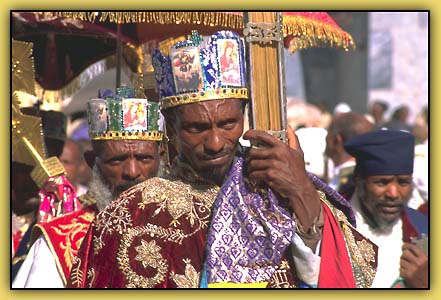
A great mystery of the Bible
In early Old Testament times the Ark of the Covenant was worshipped
by the Israelites as the embodiment of God Himself, as the sign and the
seal of His presence on earth, as the stronghold of His power, and as
the instrument of His ineffable will. Built to contain the tablets of
stone upon which the Ten Commandments had been written, it was a wooden
chest measuring three feet nine inches long by two feet three inches
high and wide. It was lined inside and out with pure gold and was
surmounted by two winged figures of cherubim that faced each other
across its heavy golden lid.
Biblical and other archaic sources speak of the Ark blazing with
fire and light, inflicting cancerous tumours and severe burns, levelling
mountains, stopping rivers, blasting whole armies and laying waste
cities. The same sources also leave no doubt that it was, for a very
long time, the cornerstone of the evolving Jewish faith: indeed when
King Solomon built the First Temple in Jerusalem his sole motive was to
create 'an house of rest for the Ark of the Covenant of the Lord'. At
some unknown date between the tenth and the sixth century BC, however,
this uniquely precious and puissant object vanished from its place in
the Holy of Holies of that Temple, vanished without song or lamentation
in the Scriptures - almost as though it had never existed at all. The
evidence suggests that it was already long gone when the armies of
Nebuchadnezzar burned Jerusalem in 587 BC. Certainly it was not in the
Second Temple which was built over the ruins of the First after the Jews
had returned from their exile in Babylon in 538 BC. Neither does it seem
to have been taken as booty by the Babylonians.
Writing in 1987, Richard Elliott Friedman, Professor of Hebrew and
Comparative Religion at the University of California, expressed a view
shared by many scholars when he described the disappearance of the
sacred relic as 'one of the great mysteries of the Bible':
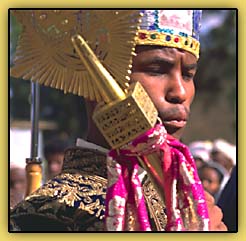 There is no report that the Ark was carried away or destroyed or
hidden. There is not even any comment such as 'And then the Ark
disappeared and we do not know what happened to it' or 'And no one knows
where it is to this day'. The most important object in the world, in the
biblical view, simply ceases to be in the story.'
There is no report that the Ark was carried away or destroyed or
hidden. There is not even any comment such as 'And then the Ark
disappeared and we do not know what happened to it' or 'And no one knows
where it is to this day'. The most important object in the world, in the
biblical view, simply ceases to be in the story.'
Indeed so. A close reading of the Old Testament reveals more than
two hundred separate references to the Ark of the Covenant up until the
time of Solomon (970-931 BC); after the reign of that wise and splendid
king it is almost never mentioned again. And this, surely, is the
central problem, the real historical enigma: not, human nature being
what it is, that an immensely valuable golden chest should go missing,
but - given its supreme religious significance - that it should go
missing amidst such a deafening, improbable silence. Like a black hole
in space, or a negative photographic image, it is identifiable in the
later books of the Old Testament only by what it is not - it is, in
short, conspicuous only by its absence.
From this it seems reasonable to suggest that some sort of cover-up
may have taken place - a cover-up devised by priests and scribes to
ensure that the whereabouts of the sacred relic would remain forever a
secret. If so then it is a secret that many have tried to penetrate - a
secret that has inspired several treasure-hunting expeditions (all of
which have failed) and also one enormously successful Hollywood fantasy,
Raiders of the Lost Ark, which was first released in the USA and Europe
in 1981 with Harrison Ford in the starring role as Indiana Jones.
I was living in Kenya at the time and had no opportunity to see the
film until it finally arrived in Nairobi's cinemas early in 1983. I
enjoyed the combination of action, adventure and archaeology and I
remember thinking what a sensation it would be if someone were really to
find the Ark. Then, only a few months later, I made an extended visit to
Ethiopia during which I travelled to the north-west of the war-torn
province of Tigray. It was there, in Axum - the so-called 'sacred city
of the Ethiopians' - that I had my encounter with the guardian
monk reported earlier in this chapter.
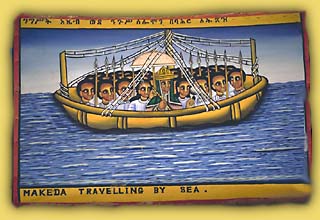
Palaces, catacombs and obelisks
Our work began the moment that we arrived. Waiting to greet us as we
stepped down from the plane was an elderly Abyssinian gentleman wearing
a slightly threadbare three-piece suit and a most splendid patriarchal
beard. In quaint but excellent English, he introduced himself as Berhane
Meskel Zelelew and explained that he had been contacted by radio from
Addis Ababa and ordered to guide us and act as our interpreter. He was
employed, he said, by the Ministry of Culture 'to keep an eye on the
antiquities of Axum'. In this capacity he had helped the archaeologists
from the British Institute in Eastern Africa whose excavations of some
of the city's most interesting ruins had been interrupted by the
revolution of 1974. 'It's so nice to see other British people here
after such a long time,' he exclaimed as we introduced ourselves.
We climbed into a vintage Land Rover with a lime-green paint job and
two neat bullet holes in the front windscreen. 'Fortunately no one was
killed,' Zelelew reassured us when we asked him about these. Laughing
nervously as we drove away from the airfield, I then explained what we
had come to do, listed the historic sites that we wanted to visit, and
told him that I was particularly intrigued by Axum's claim to be the
last resting place of the Ark of the Covenant.
Do you believe that the Ark is here?' I asked.
'Yes. Certainly.'
'And where is it exactly?'
'It is deposited in a chapel near the centre of the city.'
'Is this chapel very old?'
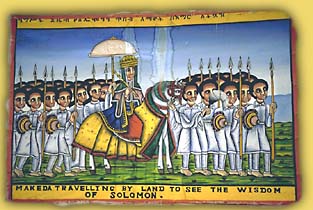
"Makeda travelling by land to see the wisdom of Solomon"
'No. Its construction was ordered by our late Emperor... in 1965 I
think. Before that the relic had rested for many hundreds of years
within the Holy of Holies of the nearby church of Saint Mary of Zion...'
Zelelew paused, then added: 'Haile Sellassie had a special interest in
this matter, by the way... He was the two hundred and twenty-fifth
direct-line descendant of Menelik, son of the Queen of Sheba and King
Solomon. It was Menelik who brought the Ark of the Covenant to our
country...'
I was all for visiting the chapel at once, but Zelelew persuaded me
that there was little point in hurrying: 'you will not be allowed
anywhere near the Ark. Where it rests is holy ground. The monks and the
citizens of Axum protect it and they would not hesitate to kill anyone
who tried to break in. Just one man is allowed to enter and he is the
monk responsible for guarding the Ark. We will try to meet him later
today, but first let us go and see the Queen of Sheba's palace.'
After we had assented to this attractive proposition we turned on to
a bumpy, potholed road that - had we been able to follow it all the way
- would eventually have led us hundreds of miles south-west, through the
gigantic peaks and valleys of the Simien mountains, to the city of
Gondar near Lake Tana. In open country barely a mile from the centre of
Axum, however, we stopped within sight of an extensively fortified
military post which, Zelelew explained, marked the limit of the
government controlled sector. He waved expressively at the nearby hills:
'Everything else TPLF, so we cannot go. It's a pity. There are so many
interesting things to see . . . There, just around that corner in the
road, are the granite quarries where all the stelae were cut. One still
remains partially unexcavated from the rock. And there is a beautiful
carving of a lioness. It is very ancient. It was put there before the
coming of Christianity. But unfortunately we cannot reach it.' '

"Makeda meets Solomon and presents him...
How far is it exactly?' I asked, tantalized.
'Very close, less than three kilometres. But the military will not
let us past the checkpoint and if they did we would certainly be taken
by the guerillas. Even here we should not stand around for too long.
Your foreign faces will be noticed by the TPLF snipers. They might think
you are Russians and decide to shoot at you...' He laughed: 'That would
be highly undesirable, would it not? Come, follow me.'
He led the way into fields to the north of the road and we quickly
began to stumble across the remains of what must, once, have been an
imposing building. 'This was the Queen of Sheba's palace,' Zelelew
announced proudly. 'According to our traditions her name was Makeda and
Axum was her capital. I know that foreigners do not accept that she was
an Ethiopian at all. Nevertheless no other country has a stronger claim
than ours.'
I asked whether any archaeology had ever been done on the site to
test the legends.
'Yes, in the late 1960s the Ethiopian Institute of Archaeology
conducted some excavations here... I helped on the dig.'
'And what was discovered?'
Zelelew made a mournful face. 'The opinion was that the palace was
not sufficiently old to have been the residence of the Queen of Sheba.'
What the archaeologists had unearthed, and what we now spent some
time exploring, were the ruins of a great and well built edifice with
finely mortared stone walls, deep foundations and an impressive drainage
system. We saw a still-intact flagstone floor - which Zelelew claimed
was a large throne room - and a number of stair-wells which hinted at
the existence of at least one upper storey. There were also private
bathing areas of sophisticated design and a well-preserved kitchen
dominated by two brick ovens.
Across the road, in a field facing the palace, we then inspected a
number of rough-hewn granite stelae, some standing more than fifteen
feet high, some fallen and broken. Most were undecorated but one, the
largest, was carved with four horizontal bands, each band topped by a
row of circles in relief - like protruding beam ends in a building made
of wood and stone. This crude obelisk Zelelew told us, was thought by
the townspeople to mark the grave of the Queen of Sheba. No excavation
work had been carried out beneath it, however, and the field was now
entirely given over to farmers who grew crops for the Axum garrison.
Even as we talked we saw two peasant boys approach with an ox, which
they harnessed to a wooden plough. Oblivious to the history that lay all
around them, and apparently indifferent to our presence as well, they
began to till the soil.
After we had finished taking pictures and notes we drove back into
the centre of the city and then out again to the north-east to another
palace complex, this one on a hill-top with commanding views of the
whole area. Square in plan, the structure measured about two hundred
feet on each side. The walls, which had long since crumbled, showed
signs of having originally been projected at the corners to form four
towers - possibly the very towers which, in the sixth century, the monk
Cosmas had described as being adorned with brass unicorns.
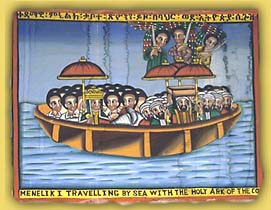
"Menelik travelling by sea with the Holy Ark of the Covenant"
Beneath the fortress Zelelew then led us down steep stone stairways
into a number of underground galleries and chambers which were roofed
and walled with massive dressed granite blocks that fitted precisely
against one another without any mortar in the joints. Local tradition,
he said, identified this cool dark warren as the treasury used by
Emperor Kaleb (AD 514-542) and also by his son Gebre-Maskal. With the
aid of a flashlight we saw the empty stone coffers which lay within
coffers believed to have once contained great riches in gold and pearls.
Further rooms, as yet unexcavated, extended into the hillside from
there, blocked off behind thick granite walls.
Eventually we left the hill-top fortress and made our way down into
the centre of Axum on a gravel road. Near the bottom of the gradient, to
our left, we paused to photograph a large, open deep-water reservoir dug
down into the red granite of the hillside and approached by means of
rough-hewn stairways. Known as the Mai Shum, it seemed to us very old -
an impression that Zelelew confirmed when he remarked that it was
originally the Queen of Sheba's pleasure bath: 'At least so our people
believe. Since the beginning of Christian times it has been used for
baptismal ceremonies to celebrate the Holy Epiphany, which we call
Timkat. And of course the peasants still come here every day to draw
their water.' As though to confirm this last observation he pointed to a
group of women carefully descending the time-worn steps bearing gourds
on their heads.
By now, without any of us really noticing how the time had passed,
it was already well past the middle of the afternoon. Zelelew urged us
to hurry, pointing out that we were scheduled to fly back to Asmara at
first light the next day and that we still had much to see.
Our next destination was close by, the so-called 'Park of the
Stelae' - certainly the focal point of Axum's archaeological interest.
Here we examined and photographed a remarkable series of giant obelisks
carved from slabs of solid granite. The most massive of these, a tumbled
fractured ruin, was believed to have fallen to the ground more than a
thousand years previously. In its heyday, though, it had stood one
hundred and ten feet tall and must have dominated the entire area. I
remembered from the reading I had done on the flight that its weight was
estimated to exceed five hundred tons. It was thought to be the largest
single piece of stone ever successfully quarried and erected in the
ancient world.

"Menelik arrives at Axum with the Holy Ark of the Convenant"
This fallen stele was painstakingly hewn to mimic a high, slender
building of thirteen storeys - each storey complete with elaborate
representations of windows and other details, and demarcated from the
next by a row of symbolic beam-ends. At the base could be discerned a
false door complete with a knocker and lock, all perfectly carved in
stone.
Another fallen - but much smaller and unbroken - obelisk, Zelelew told
us, had been stolen during the Italian occupation of 1935-41,
transported with enormous difficulty to Rome by Mussolini, and
re-erected near the Arch of Constantine. Since it, too, was elaborately
carved - and therefore of great artistic value - the Ethiopian
government was campaigning for its return. In the meantime, however, it
was fortunate that a third decorated monolith still remained in situ in
the stelae park.
With a flourish our guide now pointed to this towering stone needle,
more than seventy feet high and topped with a curved headpiece shaped
like a half- moon. We strolled over to examine it properly and found
that, like its huge neighbour, it had been carved to resemble a
conventional built-up structure - in this case a nine-storey building in
the fashion of a tower-house. Once again, the main decoration on the
front elevation was provided by the semblance of windows and of beams of
timber supposedly inserted horizontally into the walls. The intervals
between each of the floors were defined by rows of symbolic log-ends,
and the house-like appearance was further enhanced by the presence of a
false door.
Several other stelae of varying sizes were ranged around this
refined monument - all of them clearly the products of an advanced, well
organized and prosperous culture. Nowhere else in sub-Saharan Africa had
anything even remotely similar been built and, for this reason, Axum was
a mystery - its antecedents unknown, the sources of its inspiration
unremembered.
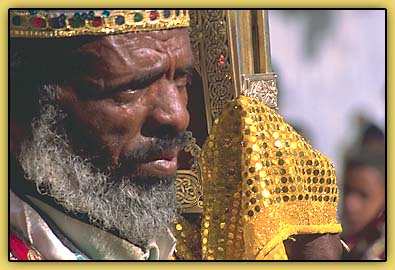
The sanctuary chapel
Across the road, directly opposite the park of the stelae, stood a
spacious walled compound containing two churches - one old and the other
obviously much more recent. These, Zelelew told us, were both dedicated
to Saint Mary of Zion. The new one, which had a domed roof and a lofty
bell- tower in the shape of an obelisk, had been built by Haile Selassie
in the 1960s. The other dated back to the mid-seventeenth century and
was the work of Emperor Fasilidas - who, like so many Ethiopian monarchs
before and since, had been crowned in Axum and had venerated the sacred
city despite making his capital elsewhere.
We found Haile Selassie's pretentious modern 'cathedral' as
unpleasant as it was uninteresting. We were attracted, however, to the
Fasilidas construction which, with its turrets and crenellated
battlements, seemed to us 'half church of God, half castle' - and thus
to belong to a truly ancient Ethiopian tradition in which the
distinctions between the military and the clergy were often blurred.
In the dimly lit interior I was able to study several striking
murals including one depicting the story of the life of Mary, another
that of the Crucifixion and Resurrection of Christ, and a third the
legend of Saint Yared - the supposed inventor of Ethiopia's eerie church
music. Faded with age, this latter work showed Yared performing before
King Gebre-Maskal. The saint's foot had been pierced by a spear dropped
from the monarch's hand but both men were so entranced by the music of
sistrum and drum that they had not noticed.
Not far from the old church were the ruins of a building that must
once have been very extensive but was now reduced to little more than
its deeply entrenched foundations. These, Zelelew explained, were the
remains of the original Saint Mary of Zion which had been built in the
fourth century AD at the time of the conversion of the Axumite kingdom
to Christianity. Some twelve hundred years later, in 1535, it had been
razed to the ground by a fanatical Muslim invader, Ahmed Gragn ('the
left-handed'), whose forces swept across the Horn of Africa from Harar
in the east and, at one time, threatened the complete extinction of
Ethiopian Christendom.
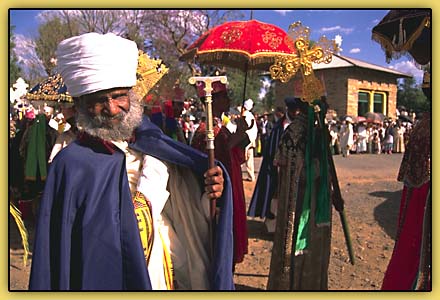
Shortly before its destruction, this 'first Saint Mary's' - as
Zelelew called it - was visited by an itinerant Portuguese friar named
Francisco Alvarez. I later looked up his description of it - the only
one that survives:
It is very large and has five naves of a good width and of a great
length, vaulted above, and all the vaults are covered up, and the
ceiling and sides are all painted; it also has a choir after our
fashion ... This noble church has a very large circuit, paved with
flagstones, like gravestones, and it has a large enclosure, and is
surrounded by another large enclosure like the wall of a large town
or city.
Zelelew rightly dated the start of construction works on the first
Saint Mary's at AD 372 - which meant that this was quite possibly
the earliest Christian church in sub-Saharan Africa. A great five-aisled
basilica, it was regarded from its inauguration as the most sacred place
in all Ethiopia. This was so because it was built to house the Ark of
the Covenant - which, if there was any truth to the legends, must have
arrived in the country long before the birth of Jesus and must then have
been co-opted by the Christian hierarchy at some point after the new
religion had been officially adopted by the Axumite state.
When Alvarez visited Saint Mary's in the 1520s - becoming, in the
process, the first European to document the Ethiopian version of the
legend of the Queen of Sheba and the birth of her only son Menelik
- the Ark was still in the Holy of Holies of the ancient church. It did
not stay there for very much longer, however. In the early 1530s, with
the invading armies of Ahmed Gragn drawing ever closer, the sacred relic
was removed 'to some other place of safekeeping' (Zelelew did not know
where). It thus escaped the destruction and looting that the Muslims
unleashed upon Axum in 1535.
A hundred years later, with peace restored throughout the empire,
the Ark was brought back in triumph and installed in the second Saint
Mary's - built by Fasilidas beside the razed remains of the first. And
there apparently it stayed until 1965 when Haile Selassie had it moved
to the new and more secure chapel put up at the same time as his own
grandiose cathedral but annexed to the seventeenth-century church.
It was in the grounds of Haile Sellassie's chapel that the guardian
monk told me his astonishing story about the Ark and warned me that it
was 'powerful'.
'How powerful?' I asked. 'What do you mean?'
The guardian's posture stiffened and he seemed suddenly to grow more
alert. There was a pause. Then he chuckled and put a question to me:
'Have you seen the stelae?'
'Yes', I replied, 'I have seen them.'
'How do you think they were raised up?'
I confessed that I did not know.
'The Ark was used,' whispered the monk darkly, 'the Ark and the
celestial fire. Men alone could never have done such a thing.'
On my return to the Ethiopian capital Addis Ababa, I took the
opportunity to conduct some research into the historical merits of the
legend that the guardian had related to me. I wanted to find out whether
there was any possibility at all that the Queen of Sheba could have been
an Ethiopian monarch. And if there was, then could she really have
journeyed to Israel in the time of Solomon - around three thousand years
ago? Could she have been impregnated by the Jewish kin? Could she have
borne him a son named Menelik? Most importantly, could that son have
made his way to Jerusalem as a young man, spent a year there at his
father's court, and then returned to Axum with the Ark of the Covenant?
*** Graham
Hancock was the East Africa correspondent for The Economist and is the
author of several previous books on Africa and the Third World. He lives
in Devonshire, England. Part fascinating scholarship and part
entertaining adventure yarn, tying together some of the most intriguing
tales of all time -- from the Knights Templar and Prester John to
Parsival and the Holy Grail -- Hancock's book, The Sign and the Seal
will appeal to anyone fascinated by the revelation of hidden truths, the
discovery of secret mysteries.
"The Sign and The Seal" ©
Graham Hancock, All Rights Reserved - Photo Credits, ©
L.Jauregui - Web Production and
Design, OneWorld Magazine. - OneWorld Magazine is hosted by
The EnviroLink Network -
OneWorld WWW Site © OneWorld Magazine - All Rights Reserved.
|

